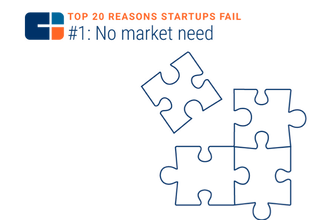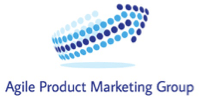Addressing The #1 Reason Startups Fail – The Case for Customer Discovery

According to CB Insights , 70% of startup tech companies fail, after raising financing and the #1 reason is No Market Need; Tackling problems that are interesting to solve rather than those that serve a market need was cited as the top reason for failure and at 42%, it dwarfs all other factors. So, as they say, an ounce of prevention is worth a pound of cure. In this case, you need a pound of prevention in discovering who your customers are and why they would want your product.
Steve Blank and Eric Ries created The Lean Startup movement and popularized the minimum viable product (MVP), which has become foundational for startups and mature companies alike; however, far too often, the MVP is a solution in search of a problem. Blank also developed what he calls the Customer Development process; it helps a company assess and validate the market for its offering. And unfortunately, it has received less attention
Steve Blank and Eric Ries created The Lean Startup movement and popularized the minimum viable product (MVP), which has become foundational for startups and mature companies alike; however, far too often, the MVP is a solution in search of a problem. Blank also developed what he calls the Customer Development process; it helps a company assess and validate the market for its offering. And unfortunately, it has received less attention
and is often overlooked or discarded by many founders. Founders with a technical background who tend to be more focused (and comfortable with) product development often have the mindset "if we build it, they will come," and don't conduct customer discovery. But also, by highly successful salespeople turned CEOs who have been historically driven by the confidence they can find and close business through innate skill and determination.
The main goal of early-stage founders is to build a product people want; however, many companies fail because they are focused on the product and not the problem they are solving. Companies often develop products and services based on minor pain points that customers don't really care about and spend considerable time and money before the product addresses the major pains, assuming they haven't run out of time and money. The customer discovery process came into being to determine which customer segments to target and align the product to their problems, reducing costly mistakes, helping to focus MVP development and customer acquisition
CUSTOMER DISCOVERY: CUSTOMER-PROBLEM-SOLUTION ALIGNMENT
Customer Development is a process for questioning your core business assumptions. Your product or business idea fundamentally starts with an implicit or explicit assumption about three things- the customer, the problem, and the solution. If any of your assumptions are wrong, your business is toast! And if you have them aligned, you will invest in the right product, for the right audience, and the right messaging to reach that audience.
Customer Discovery is the process of focusing on four blocks of the lean canvas, developing assumptions, and turning those assumptions into hypotheses which founders will then go out and test.
The main goal of early-stage founders is to build a product people want; however, many companies fail because they are focused on the product and not the problem they are solving. Companies often develop products and services based on minor pain points that customers don't really care about and spend considerable time and money before the product addresses the major pains, assuming they haven't run out of time and money. The customer discovery process came into being to determine which customer segments to target and align the product to their problems, reducing costly mistakes, helping to focus MVP development and customer acquisition
CUSTOMER DISCOVERY: CUSTOMER-PROBLEM-SOLUTION ALIGNMENT
Customer Development is a process for questioning your core business assumptions. Your product or business idea fundamentally starts with an implicit or explicit assumption about three things- the customer, the problem, and the solution. If any of your assumptions are wrong, your business is toast! And if you have them aligned, you will invest in the right product, for the right audience, and the right messaging to reach that audience.
Customer Discovery is the process of focusing on four blocks of the lean canvas, developing assumptions, and turning those assumptions into hypotheses which founders will then go out and test.
- Customer segments: We think our target customer profile has this set of characteristics
- Problem: The set of problems we think need solving.
- Solution: How we believe that we can solve these problems
- Value proposition why a customer will pay for this solution
WHEN SHOULD YOU CONDUCT CUSTOMER DISCOVERY?
While every startup is different, and every product is different, whether your company is bootstrapped or venture-funded, it's never too early to conduct customer discovery. And a general guideline would be that if you haven't achieved product-market-fit, you should be performing customer discovery. Even if you only have a product idea, are designing a prototype, building your product, or have finished a product, but few to no customers, discovery will provide critical insights. There's no strict definition or metrics to mark this key milestone, however. If you have a product and several customers, but little market traction, i.e., you can't find more customers, and you're not generating revenue, then you haven't reached product-market fit. Customer discovery is not a one-time exercise; it's an iterative process. You will likely need to make changes to your hypotheses and re-test them. And in technology markets, the customers, their problems, and competitive products are always evolving, which creates opportunities to revisit customer discovery.
WHY DO CUSTOMER DISCOVERY?
Why not just skip discovery and build your MVP? Another way to think of this customer discovery is that it mirrors "shift left testing in software development. When developers don't test early, requirements, architecture, and design defects aren't uncovered and fixed until after wasting significant effort on implementation. Just as software defects are easier and less expensive to correct before code is compiled, sold, and in the marketplace, the wrong assumptions about customers-problems and solutions can be disastrous.
A plan is not enough, completing a business plan, business canvas, lean canvas, and even having funding because your initial market assumptions about the customer, problem, or solution are likely to be wrong for any or all of them. The customer discovery process is a critical exercise and essential investment for every early-stage company. It's a reality check on your plans because, according to Steve Blank, "no business plan survives first contact with a customer or as the boxer Mike Tyson says, "everyone has a plan until they get hit in the face."
If operating in "stealth mode" and the perceived advantage of being "first to market" is more significant than "fitting the market and customer discovery is replaced by "market research," it serves to support your assumptions rather than validate them. When startups go straight from concept to product to scaling with little external validation, It's an accident waiting to happen and triggers what Blank calls the startup death spiral. In the B2B world, the downward cycle is almost inevitable: the product needs to be re-designed to meet customers, needs, cash is burned, while little comes in, sales, marketing, and product teams start finger-pointing, heads roll and morale plummets.
Because of the increased chances of implosion and chaos, investors consider proof of customer validation as one of the most critical factors when considering investing in an early-stage company. Startups that don't conduct customer discovery find it challenging to show market validation. For those that do, it sets them apart from the others under consideration by the same funding source.
CONCLUSION: CUSTOMER DISCOVERY DRAMATICALLY SHIFTS THE ODDS OF SUCCESS IN YOUR FAVOR
Most startup founders are familiar with the concept of MVP, and there's little disagreement on the wisdom of building an MVP. However, the path to building the MVP and when you should build it has received far less attention and often gets overlooked to the detriment of many a startup. When your startup conducts customer discovery and applies a learning process, and develops a business model based on facts, rather than immediately executing based on assumptions, it can give you an edge over your competition. The advantages of customer discovery are that you don't spend limited time and money on product development or sales to see what works, but rather save the money for executing and scaling what you have already shown to work. If a startup properly conducts customer development, it helps them become highly focused, capital and resource-efficient, and while not a guaranteed success, more likely to achieve product-market fit, improve valuations, and attract additional investment.


